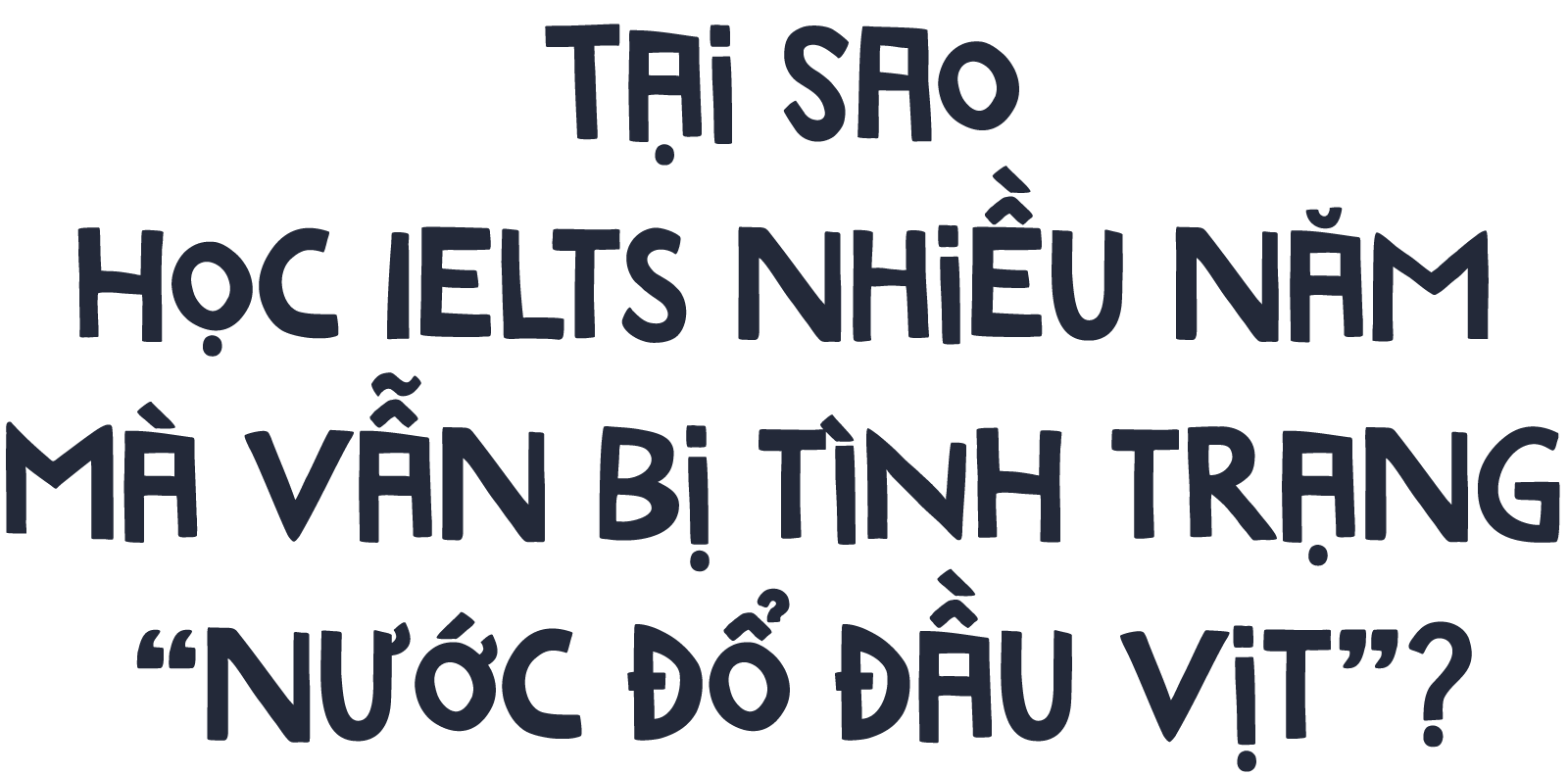Chủ đề Transportation IELTS Speaking part 1 thường xuyên xuất hiện trong kỳ thi IELTS Speaking. Để hiệu quả trong việc làm phần này, thí sinh cần sở hữu từ vựng phong phú và có khả năng nói một cách tự tin và tự nhiên. Dưới đây, Bacsiielts.vn sẽ giới thiệu một mẫu câu trả lời về chủ đề Transportation trong IELTS Speaking Part 1, cùng với một số từ vựng hữu ích.
1. Từ vựng chủ đề Transportation IELTS Speaking part 1
Dưới đây là một số từ vựng bạn cần biết để áp dụng vào chủ đề Transportation IELTS Speaking part 1:
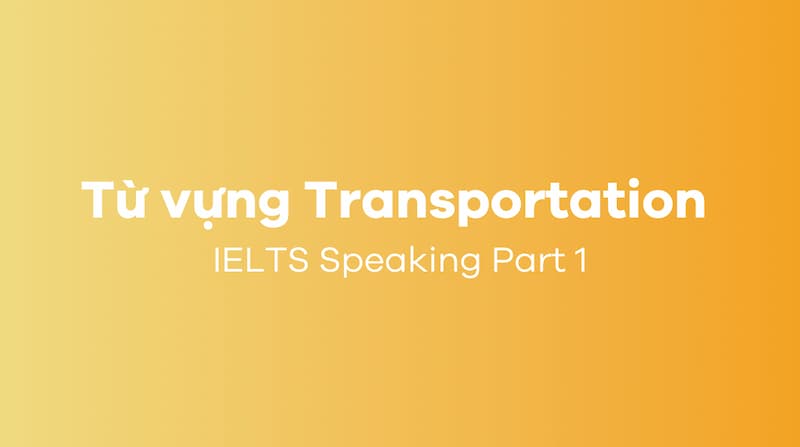
| STT | Từ vựng | Phiên âm | Từ loại | English meaning | Nghĩa Tiếng Việt |
| 1 | mode of transport | a method or mode of transportation from one location to another | phương tiện vận chuyển | ||
| 2 | navigating | /ˈnævɪˌɡeɪtɪŋ/ | (verb) | traveling along or guiding a path | điều hướng |
| 3 | congested | /kənˈdʒɛstɪd/ | (adjective) | Vehicles move slowly or stand still due to high traffic density on the road. | tắc nghẽn |
| 4 | affordable | /əˈfɔːrdəbl/ | (adjective) | budget-friendly, reasonably priced | giá cả phải chăng |
| 5 | convenient | /kənˈviːniənt/ | (adjective) | user-friendly, accessible, convenient | tiện lợi |
| 6 | versatile | /ˈvɜːrsətaɪl/ | (adjective) | versatile, capable of multitasking | linh hoạt |
| 7 | urban areas | regions or cities with high population density | khu vực đô thị | ||
| 8 | traffic conditions | the condition of traffic congestion and the flow of vehicles | tình trạng giao thông | ||
| 9 | infrastructure | /ˈɪnfrəˌstrʌktʃər/ | (noun) | the fundamental physical and organizational infrastructure required for the functioning of a society | cơ sở hạ tầng |
| 10 | traffic congestion | the condition of excessive vehicles on the road leading to delays | tắc nghẽn giao thông | ||
| 11 | efficient | /ɪˈfɪʃənt/ | (adjective) | efficient with minimal time or resource wastage | hiệu quả |
| 12 | motorized vehicles | vehicles propelled by motors or engines | phương tiện có động cơ | ||
| 13 | awareness | /əˈwɛr.nəs/ | (noun) | consciousness or realization of something | nhận thức |
| 14 | sustainable | /səˈsteɪnəbl/ | (adjective) | able to continue over the long term without depleting resources or causing harm to the environment | bền vững |
| 15 | traffic jams | circumstances where vehicles experience difficulty in moving smoothly due to traffic congestion | tắc nghẽn giao thông | ||
| 16 | alternatives | /ɔːlˈtɜːrnətɪvz/ | (noun) | other choices or options | lựa chọn thay thế |
| 17 | rush hours | periods during the day characterized by intense traffic as a result of commuting to or from work | giờ cao điểm | ||
| 18 | carpooling | /ˈkɑːrˌpuːlɪŋ/ | (noun) | the act of commuting with others, often with the goal of economizing and alleviating traffic congestion | chia sẻ xe |
| 19 | modernizing | /ˈmɒdərnaɪzɪŋ/ | (verb) | updating or making more contemporary | hiện đại hóa |
2. IELTS Speaking part 1 chủ đề Transport
Dưới đây Bác sĩ IELTS đã tổng hợp cho bạn 18 câu hỏi kèm câu trả lời cho bài Transportation IELTS Speaking part 1. Hãy cùng chinh phục chủ đề này nhé.
2.1. What is your mode of transportation for commuting to work/school?
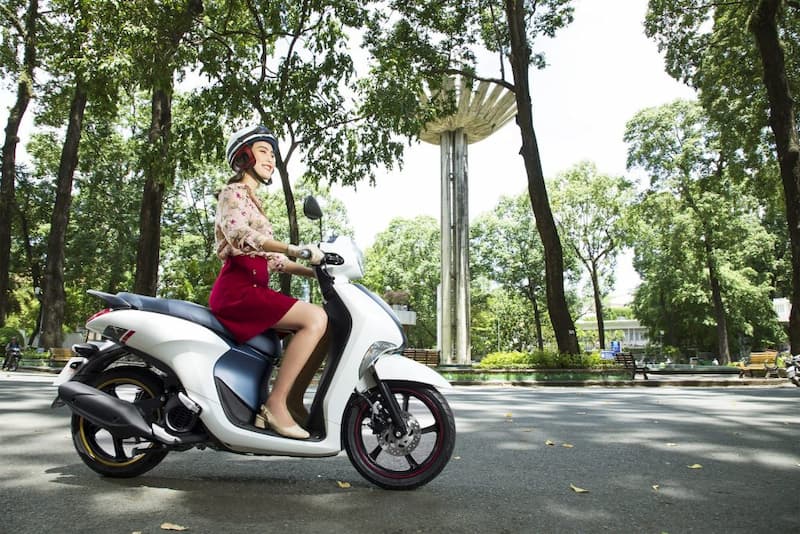
Câu hỏi 1: Phương tiện di chuyển của bạn để đi làm/đi học là gì?
Trả lời: I typically commute to work or school using a motorbike, as it is the most common mode of transport in this area and well-suited for navigating through the frequently congested and narrow streets.
Dịch nghĩa: Tôi thường đi làm hoặc đến trường bằng xe máy, vì đó là phương tiện vận chuyển phổ biến nhất trong khu vực này và phù hợp để di chuyển qua những con đường thường xuyên tắc nghẽn và hẹp.
Từ vựng cần ghi nhớ:
| Từ vựng | Phiên âm | Loại từ | Nghĩa |
| mode of transport | phương tiện vận chuyển | ||
| well-suited | /wɛl-suːt/ | (adjective) | phù hợp |
| navigating | /ˈnævɪˌɡeɪtɪŋ/ | (verb) | điều hướng |
| congested | /kənˈdʒɛstɪd/ | (adjective) | tắc nghẽn |
| narrow | /ˈnæroʊ/ | (adjective) | hẹp |
2.2. What is the most commonly used mode of transportation in your hometown?
Câu hỏi 2: Phương tiện giao thông được sử dụng phổ biến nhất ở quê hương bạn là gì?
Trả lời: In my hometown, motorbikes serve as the primary means of transportation. They are affordable, convenient, and versatile, making them the go-to choice for many residents.
Dịch nghĩa: Ở quê tôi, xe máy đóng vai trò là phương tiện vận chuyển chính. Chúng có giá phải chăng, tiện lợi và linh hoạt, là lựa chọn hàng đầu của nhiều cư dân.
Từ vựng cần ghi nhớ:
| Từ vựng | Phiên âm | Loại từ | Nghĩa |
| means of transportation | phương tiện vận chuyển | ||
| affordable | /əˈfɔːrdəbl/ | (adjective) | giá cả phải chăng |
| convenient | /kənˈviːniənt/ | (adjective) | tiện lợi |
| versatile | /ˈvɜːrsətaɪl/ | (adjective) | linh hoạt |
| go-to choice | lựa chọn hàng đầu | ||
| residents | /ˈrɛzɪdənts/ | (noun) | cư dân |
2.3. What is the distance between your home and your workplace/school?

Câu hỏi 3: Khoảng cách giữa nhà bạn và nơi làm việc/trường học của bạn là bao nhiêu?
Trả lời: The distance from my home to school/work is roughly 8 kilometers. It’s a manageable distance, and my motorbike commute typically takes me around 35 minutes, depending on traffic conditions.
Dịch nghĩa: Khoảng cách từ nhà tôi đến trường/công việc là khoảng 8 kilomet. Đó là một khoảng cách dễ quản lý, và thường thì việc đi làm bằng xe máy của tôi mất khoảng 35 phút, tùy thuộc vào tình trạng giao thông.
Từ vựng cần ghi nhớ:
| Từ vựng | Phiên âm | Loại từ | Nghĩa |
| manageable | /ˈmænɪdʒəbl/ | (adjective) | có thể quản lý |
| commute | /kəˈmjuːt/ | (noun) | hành trình đi học hoặc làm việc hàng ngày |
| depending on | tùy thuộc vào | ||
| traffic conditions | tình trạng giao thông |
2.4. Will people be able to drive more in the future, in your opinion?
Câu hỏi 4: Theo bạn, liệu mọi người có thể lái xe nhiều hơn trong tương lai không?
Trả lời: It’s conceivable that individuals in Vietnam will persist in depending on motorized means of transportation such as cars and motorbikes in the future. With economic growth, a greater number of people can afford private vehicles, potentially leading to heightened traffic congestion and pollution. Nevertheless, there is an increasing awareness of environmental concerns, prompting some individuals to opt for more eco-friendly alternatives or consider public transportation.
Dịch nghĩa: Có thể nhiều người tại Việt Nam sẽ tiếp tục phụ thuộc vào các phương tiện di chuyển có động cơ như ô tô và xe máy trong tương lai. Khi nền kinh tế phát triển, có nhiều người có khả năng mua các phương tiện cá nhân, có thể dẫn đến tình trạng tăng cường ùn tắc giao thông và ô nhiễm. Tuy nhiên, có sự nhận thức ngày càng cao về các vấn đề môi trường, khiến cho một số người chọn các phương án thân thiện với môi trường hơn hoặc xem xét các lựa chọn giao thông công cộng.
Từ vựng cần ghi nhớ:
| Từ vựng | Phiên âm | Loại từ | Nghĩa |
| motorized vehicles | phương tiện có động cơ | ||
| economy | /ɪˈkɒnəmi/ | (noun) | nền kinh tế |
| private vehicles | phương tiện cá nhân | ||
| contribute to | đóng góp vào | ||
| increased | /ɪnˈkriːst/ | (adjective) | gia tăng |
| traffic congestion | tắc nghẽn giao thông | ||
| pollution | /pəˈluːʃən/ | (noun) | ô nhiễm |
| awareness | /əˈwɛr.nəs/ | (noun) | nhận thức |
| environmental issues | vấn đề môi trường | ||
| eco-friendly | /ˌiːkoʊˈfrɛndli/ | (adjective) | thân thiện với môi trường |
| alternatives | /ɔːlˈtɜːrnətɪvz/ | (noun) | lựa chọn thay thế |
2.5. Which mode of transportation do you favor, and what is the reason for your preference?
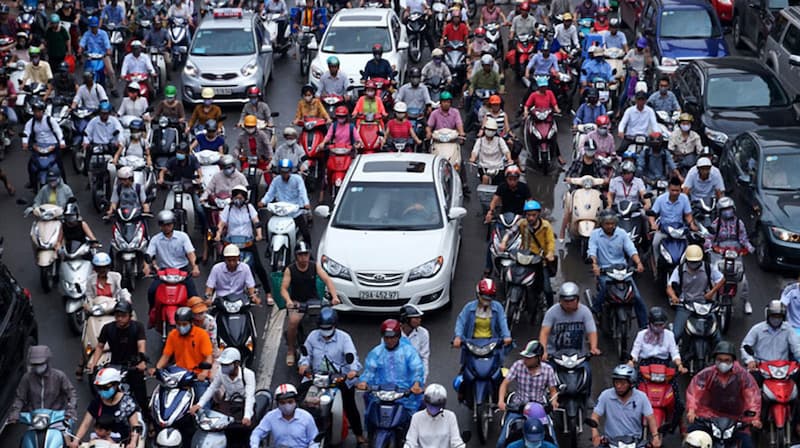
Câu hỏi 5: Bạn thích phương thức vận chuyển nào nhất và lý do bạn lựa chọn là gì?
Trả lời: For my daily commute, I favor using motorbikes, which are the prevailing and convenient means of transportation in this area. They enable me to navigate through traffic effortlessly and are well-suited to the narrow roads in various locations.
Dịch nghĩa: Đối với hành trình đi lại hàng ngày của tôi, tôi ưa thích sử dụng xe máy, đó là phương tiện vận chuyển phổ biến và tiện lợi nhất trong khu vực này. Chúng giúp tôi điều hướng qua giao thông một cách dễ dàng và phù hợp với những con đường hẹp ở nhiều khu vực.
Từ vựng cần ghi nhớ:
| Từ vựng | Phiên âm | Loại từ | Nghĩa |
| convenient | /kənˈviːniənt/ | (adjective) | tiện lợi |
| navigate | /ˈnævɪˌɡeɪt/ | (verb) | điều hướng |
| well-suited | /wɛl-suːt/ | (adjective) | phù hợp |
2. 6. Did you take public transportation when you were a kid?
Câu hỏi 6: Bạn có sử dụng phương tiện công cộng khi còn nhỏ không?
Trả lời: I took a train journey once when I was around five years old. It was during a trip to visit my grandparents’ hometown, which was approximately 450 km away from the city where I resided at that time.
Dịch nghĩa: Tôi đã có một chuyến đi tàu một lần khi tôi khoảng năm tuổi. Đó là trong một chuyến đi thăm quê ngoại của tôi, nằm khoảng 450km từ thành phố tôi sống vào thời điểm đó.
2.7. How frequently do you utilize buses?
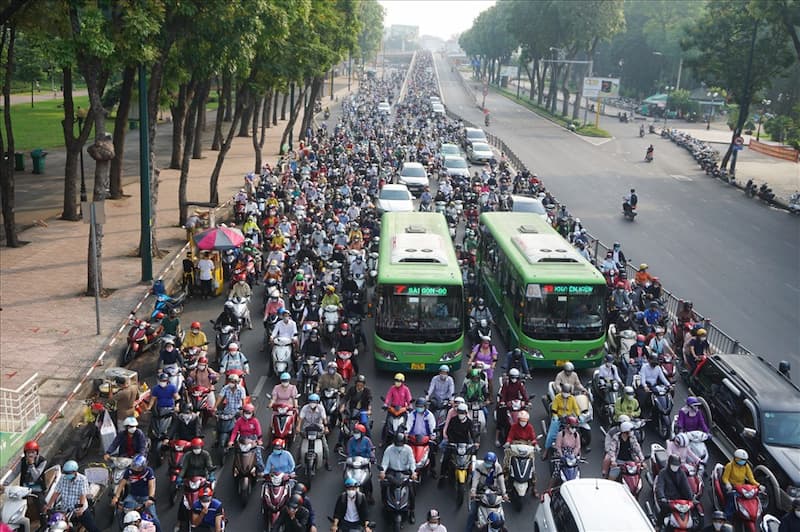
Câu hỏi 7: Bạn có thường xuyên sử dụng xe buýt không?
Trả lời: I seldom use buses. Although buses are accessible, they may be less efficient and comfortable in comparison to motorbikes or taxis. My primary mode of transportation for daily needs is predominantly motorbikes.
Dịch nghĩa: Tôi hiếm khi sử dụng xe buýt. Mặc dù có sẵn xe buýt, chúng có thể không hiệu quả và thoải mái bằng so với việc sử dụng xe máy hoặc taxi. Chủ yếu, tôi dựa vào việc sử dụng xe máy cho nhu cầu vận chuyển hàng ngày của mình.
Từ vựng cần ghi nhớ:
| Từ vựng | Phiên âm | Loại từ | Nghĩa |
| efficient | /ɪˈfɪʃənt/ | (adjective) | hiệu quả |
| comfortable | /ˈkʌmftəbl/ | (adjective) | thoải mái |
| compared to | so sánh với | ||
| transportation needs | nhu cầu vận chuyển |
2.8. Could you contrast the benefits of planes and trains?
Câu hỏi 8: Bạn có thể so sánh lợi ích của máy bay và tàu hỏa không?
Trả lời: Airplanes are frequently the favored option for long-distance journeys, particularly when you need to traverse a considerable distance swiftly. Trains, conversely, are more frequently employed for intermediate-distance travel within the country. They can provide a pleasant and picturesque voyage, but they generally have a slower pace in comparison to airplanes.
Dịch nghĩa: Máy bay thường là sự lựa chọn được ưa chuộng cho các hành trình xa, đặc biệt là khi bạn cần di chuyển một khoảng cách đáng kể một cách nhanh chóng. Tàu hỏa, ngược lại, thường được sử dụng nhiều hơn cho các hành trình trung bình trong nước. Chúng có thể mang lại một chuyến đi thoải mái và đẹp mắt, nhưng thường chậm hơn so với máy bay.
Từ vựng cần ghi nhớ:
| Từ vựng | Phiên âm | Loại từ | Nghĩa |
| distance | /ˈdɪstəns/ | (noun) | khoảng cách |
2.9. What is the amount of time you typically dedicate to traveling on an ordinary day?
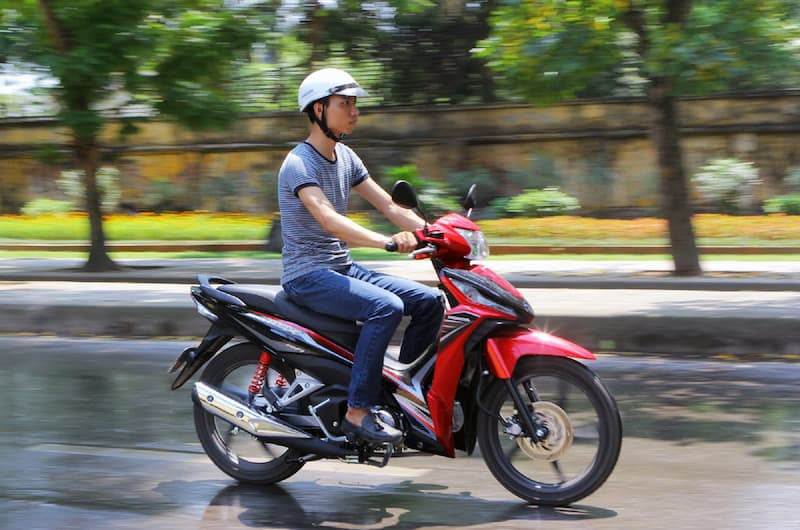
Câu hỏi 9: Lượng thời gian bạn thường dành để đi lại trong một ngày bình thường là bao nhiêu?
Trả lời: During an average day, my commuting time typically ranges from around 30 minutes to an hour when traveling to and from work or school. Nevertheless, these durations can fluctuate considerably based on the prevailing traffic conditions.
Dịch nghĩa: Trong một ngày bình thường, thời gian đi lại của tôi thường dao động từ khoảng 30 phút đến một giờ khi di chuyển đến và từ nơi làm việc hoặc trường học. Tuy nhiên, thời gian này có thể biến động đáng kể tùy thuộc vào điều kiện giao thông hiện tại.
2.10. Do you mean, will you ride a bike to work in the future?
Câu hỏi 10: Bạn có nghĩa, bạn sẽ đi xe đạp để đi làm trong tương lai không?
Trả lời: Certainly, I would contemplate commuting to work on a bicycle in the future if there are enhancements in infrastructure and improved safety conditions. Biking can be an eco-friendly and health-conscious choice, particularly for shorter distances.
Dịch nghĩa: Tất nhiên, tôi sẽ xem xét việc đi làm bằng xe đạp trong tương lai nếu có cải thiện về hạ tầng và điều kiện an toàn. Đi xe đạp có thể là một lựa chọn thân thiện với môi trường và tốt cho sức khỏe, đặc biệt là cho các quãng đường ngắn.
Từ vựng cần ghi nhớ:
| Từ vựng | Phiên âm | Loại từ | Nghĩa |
| infrastructure | /ˈɪnfrəˌstrʌktʃər/ | (noun) | cơ sở hạ tầng |
| safety | /ˈseɪfti/ | (noun) | an toàn |
| conditions | /kənˈdɪʃənz/ | (noun) | điều kiện |
2.11. Do you favor public transportation or private transportation?
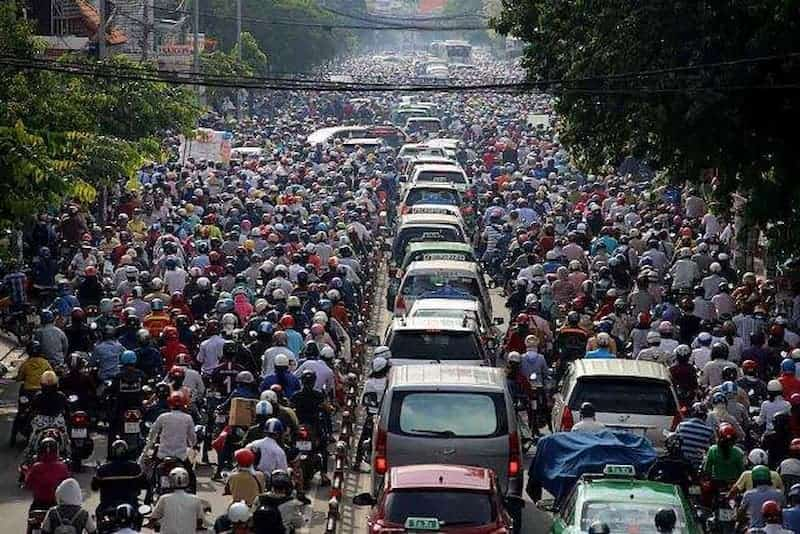
Câu hỏi 11: Bạn thích phương tiện giao thông công cộng hay phương tiện cá nhân?
Trả lời: In my opinion, I lean towards using private transportation primarily because of the convenience and flexibility it provides. Although public transport is available, it might not consistently match the efficiency or comfort of private alternatives, especially in densely populated urban zones.
Dịch nghĩa: Theo quan điểm của tôi, tôi ưa chuộng việc sử dụng phương tiện giao thông cá nhân chủ yếu vì sự thuận tiện và linh hoạt mà nó mang lại. Mặc dù có các phương tiện giao thông công cộng, nhưng chúng có thể không luôn đạt được sự hiệu quả hoặc thoải mái như các lựa chọn cá nhân, đặc biệt là ở những khu vực đô thị đông đúc.
Từ vựng cần ghi nhớ:
| Từ vựng | Phiên âm | Loại từ | Nghĩa |
| convenience | /kənˈviːniəns/ | (noun) | tiện lợi |
| flexibility | /ˌflɛksɪˈbɪləti/ | (noun) | tính linh hoạt |
| efficient | /ɪˈfɪʃənt/ | (adjective) | hiệu quả |
Các bài viết liên quan:
IELTS Speaking part 1 hometown
IELTS Speaking Part 1 Education
IELTS Speaking part 1 HOLIDAYS
IELTS Speaking Part 1 Work And Study
2.12. How has transportation in your country changed from the past to the present?
Câu hỏi 12: Giao thông vận tải ở nước bạn đã thay đổi như thế nào từ xưa đến nay?
Trả lời: The transportation landscape in Vietnam has experienced notable transformations over the years. Historically, bicycles dominated as the main mode of transportation. However, with economic progress, motorbikes and cars have gained prevalence. This shift has brought about challenges such as traffic congestion and increased pollution.
Dịch nghĩa: Toàn cảnh vận tải tại Việt Nam đã trải qua những biến động đáng kể qua các năm. Lịch sử, xe đạp là phương tiện chủ yếu. Tuy nhiên, với sự phát triển kinh tế, xe máy và ô tô đã trở nên phổ biến hơn. Sự thay đổi này mang lại những thách thức như tắc nghẽn giao thông và tăng cường ô nhiễm.
Từ vựng cần ghi nhớ:
| Từ vựng | Phiên âm | Loại từ | Nghĩa |
| mode of transport | phương tiện di chuyển | ||
| challenges | /ˈʧælɪndʒɪz/ | (noun) | thách thức |
| traffic congestion | tắc nghẽn giao thông | ||
| pollution | /pəˈluːʃən/ | (noun) | ô nhiễm |
2.13. What forms of public transportation are available in your city?

Câu hỏi 13: Những hình thức giao thông công cộng nào có sẵn trong thành phố của bạn?
Trả lời: In my city, there are different forms of public transportation, such as buses and taxis. Moreover, motorbike taxis, commonly referred to as ‘xe ôm,’ are readily accessible for short-distance journeys.
Dịch nghĩa: Trong thành phố của tôi, có nhiều hình thức giao thông công cộng khác nhau, như xe buýt và taxi. Thêm vào đó, dịch vụ taxi máy, thường được gọi là ‘xe ôm,’ rất dễ tiếp cận để di chuyển trong khoảng cách ngắn.
2.14. Are there any transportation issues or challenges in your city?
Câu hỏi 14: Có bất kỳ vấn đề hoặc thách thức giao thông nào trong thành phố của bạn không?
Trả lời: Certainly, traffic congestion stands out as a significant transportation challenge in my city. The swift rise in the volume of vehicles on the roads has resulted in frequent traffic jams, particularly during peak hours.
Dịch nghĩa: Đúng vậy, tắc nghẽn giao thông nổi bật như một thách thức giao thông quan trọng trong thành phố của tôi. Sự tăng nhanh về lượng phương tiện trên đường đã dẫn đến tình trạng kẹt xe thường xuyên, đặc biệt là vào giờ cao điểm.
Từ vựng cần ghi nhớ:
| Từ vựng | Nghĩa |
| traffic jams | tắc nghẽn, ùn tắc giao thông |
2.15. What measures could be taken to address that issue?
Câu hỏi 15: Những biện pháp nào có thể được thực hiện để giải quyết vấn đề đó?
Trả lời: To tackle the problem of traffic congestion in my city, authorities could allocate resources to enhance and modernize public transportation, establish designated bike lanes, advocate for carpooling, and promote the adoption of electric vehicles. Enforcing more stringent traffic regulations and implementing congestion pricing could also contribute to better traffic management.
Dịch nghĩa: Để giải quyết vấn đề kẹt xe trong thành phố của tôi, các cơ quan chức năng có thể dành nguồn lực để cải thiện và hiện đại hóa các phương tiện giao thông công cộng, thiết lập làn đường dành cho xe đạp, khuyến khích chia sẻ xe, và thúc đẩy việc sử dụng các phương tiện điện. Việc thực hiện các quy định giao thông nghiêm túc hơn và áp dụng chính sách giảm tắc nghẽn cũng có thể đóng góp vào việc quản lý giao thông hiệu quả hơn.
Từ vựng cần ghi nhớ:
| Từ vựng | Phiên âm | Loại từ | Nghĩa |
| authorities | /əˈθɔrətiz/ | (noun) | các cơ quan chức năng |
| modernizing | /ˈmɒdərnaɪzɪŋ/ | (verb) | hiện đại hóa |
| promote | /prəˈmoʊt/ | (verb) | thúc đẩy |
| carpooling | /ˈkɑːrˌpuːlɪŋ/ | (noun) | chia sẻ xe |
| Implementing | /ˈɪmplɪˌmɛntɪŋ/ | (verb) | triển khai |
| congestion pricing | chi phí cảnh báo tắc nghẽn giao thông |
2.16. Do you anticipate an increase in the number of people using public transportation in the future?
Câu hỏi 16: Bạn có dự đoán được sự gia tăng số lượng người sử dụng phương tiện giao thông công cộng trong tương lai không?
Trả lời: It’s likely that an increasing number of individuals will opt for public transportation in the future in Vietnam, particularly with the rising population density in cities and growing environmental awareness. However, this will hinge on enhancements in public transport infrastructure, convenience, and affordability.
Dịch nghĩa: Có khả năng một số người ngày càng chọn lựa sử dụng phương tiện giao thông công cộng trong tương lai tại Việt Nam, đặc biệt là khi mật độ dân số tăng cao ở các thành phố và ý thức môi trường ngày càng tăng. Tuy nhiên, điều này sẽ phụ thuộc vào việc cải thiện hạ tầng giao thông công cộng, sự thuận tiện và khả năng chi trả.
Từ vựng cần ghi nhớ:
| Từ vựng | Phiên âm | Loại từ | Nghĩa |
| infrastructure | /ˈɪnfrəˌstrʌktʃər/ | (noun) | cơ sở hạ tầng |
| convenience | /kənˈviːniəns/ | (noun) | tiện lợi |
| affordability | /əˌfɔːrdəˈbɪləti/ | (noun) | khả năng chi trả |
2.17. In your opinion, should people use public transportation more often?

Câu hỏi 17: Theo bạn, mọi người có nên sử dụng phương tiện công cộng thường xuyên hơn không?
Trả lời: Certainly, I think individuals in Vietnam, especially in urban regions, should make greater use of public transportation. This can contribute to alleviating traffic congestion, decreasing pollution, and fostering the development of more sustainable and livable cities.
Dịch nghĩa: Chắc chắn, tôi nghĩ rằng mọi người tại Việt Nam, đặc biệt là ở các khu vực đô thị, nên tận dụng nhiều hơn các phương tiện giao thông công cộng. Điều này có thể giúp giảm ùn tắc giao thông, giảm mức độ ô nhiễm, và thúc đẩy sự phát triển của các thành phố bền vững và sống được.
2.18. Do you plan to increase your usage of public transport in the future?
Câu hỏi 18: Bạn có kế hoạch tăng cường sử dụng phương tiện giao thông công cộng trong tương lai không?
Trả lời: Certainly. As public transportation options advance and become more user-friendly, I am more likely to utilize them in the future. Not only does it contribute to lessening the environmental footprint, but it also provides a more stress-free and economical means of commuting, particularly in urban settings with high traffic volumes.
Dịch nghĩa: Tất nhiên. Khi các tùy chọn giao thông công cộng tiến bộ và trở nên thân thiện hơn với người sử dụng, tôi khả năng cao sẽ sử dụng chúng hơn trong tương lai. Điều này không chỉ giúp giảm thiểu ảnh hưởng đến môi trường mà còn cung cấp một phương tiện di chuyển thoải mái và tiết kiệm chi phí, đặc biệt là ở các khu vực đô thị có mật độ giao thông cao.
Tham khảo thêm:
IELTS Speaking Home Accommodation
IELTS Speaking part 1 chủ đề CONCENTRATION
3. Lời kết
Hãy ghi chép các câu trả lời mẫu trên cho chủ đề Transportation IELTS Speaking part 1 để có hiệu quả tốt trong quá trình ôn tập. Hy vọng rằng thông qua bài viết này, bạn sẽ có thêm từ vựng và ý tưởng cần thiết để chuẩn bị cho phần thi IELTS Speaking part 1 của mình.

